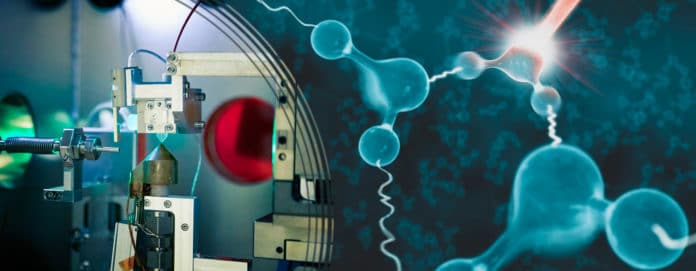For the first time, scientists from the Department of Energy’s SLAC National Accelerator Laboratory, Stanford University, and Stockholm University in Sweden directly observed how hydrogen atoms in water molecules tug and push neighboring water molecules when they are excited with laser light.
Water exhibits many strange behaviors. Scientists are still struggling to explain that behavior.
This new study unveils effects that could nurture key aspects of the microscopic origin of water’s strange properties. It could also lead to a better understanding of how water helps proteins function in living organisms.
Anders Nilsson, a professor of chemical physics at Stockholm University, said, “Although this so-called nuclear quantum effect has been hypothesized to be at the heart of many of water’s strange properties, this experiment marks the first time it was ever observed directly. The question is if this quantum effect could be the missing link in theoretical models describing the anomalous properties of water.”
Water consists of oxygen, hydrogen, and a web of hydrogen bonds between positively charged hydrogen atoms in one molecule, and negatively charged oxygen atoms in neighboring molecules hold them together. This network prompts many of water’s inexplicable properties.
Until now, she was unable to observe how a water molecule interacts with its neighbors directly.
Collaborator Kelly Gaffney, a scientist at the Stanford Pulse Institute at SLAC, said, “The low mass of the hydrogen atoms accentuates their quantum wave-like behavior. This study is the first to directly demonstrate that the response of the hydrogen bond network to an impulse of energy depends critically on the quantum mechanical nature of how the hydrogen atoms are spaced out, which has long been suggested to be responsible for the unique attributes of water and its hydrogen bond network.”
For the study, scientists used SLAC’s MeV-USD, a high-speed “electron camera” to detect molecular movements by scattering a powerful beam of electrons off samples. Scientists created 100-nanometer-thick jets of liquid water—about 1,000 times thinner than the width of a human hair—and set the water molecules vibrating with infrared laser light. Then they blasted the molecules with short pulses of high-energy electrons from MeV-USD.
This generated high-resolution snapshots of the molecules’ shifting atomic structure that they strung together into a stop-motion movie of how the network of water molecules responded to the light.
Through these snapshots, scientists were able to see the vibration of an excited water molecule. They also found that the hydrogen atom tugs oxygen atoms from neighboring water molecules closer before pushing them away with its newfound strength, expanding the space between the molecules.
Jie Yang, a former SLAC scientist and now a professor at Tsinghua University in China, said, “For a long time, researchers have been trying to understand the hydrogen bond network using spectroscopy techniques. The beauty of this experiment is that for the first time, we were able to observe how these molecules move directly.”
Using the method, scientists expect to get more insight into the quantum nature of hydrogen bonds and their role in water’s strange properties. Scientists are also planning to study the critical role these properties play in many chemical and biological processes.
Xijie Wang, a SLAC distinguished staff scientist and study collaborator, said, “This has opened a new window to study water. Now that we can finally see the hydrogen bonds moving, we’d like to connect those movements with the broader picture, which could shed light on how water led to the origin and survival of life on Earth and inform the development of renewable energy methods.”
Journal Reference:
- Direct observation of ultrafast hydrogen bond strengthening in liquid water, Nature (2021). DOI: 10.1038/s41586-021-03793-9
